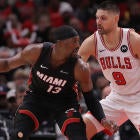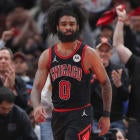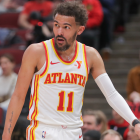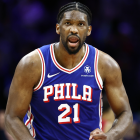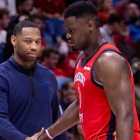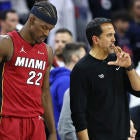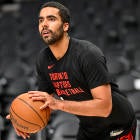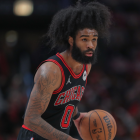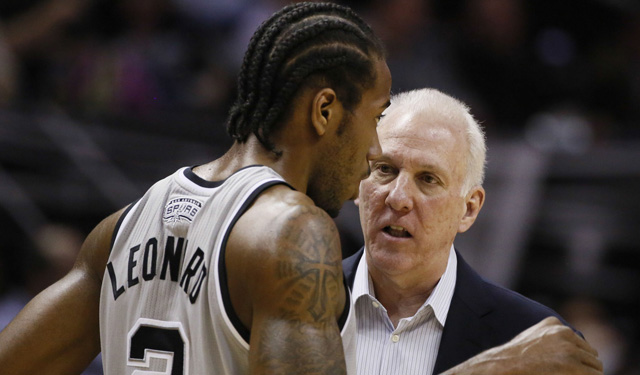
More NBA: Power Rankings | Expert Picks | Latest news & notes
Not everybody improves.
Improvement in basketball is often assumed as a linear function. A player at a young age begins playing the game and through each stage of their playing career -- if they're good enough to make the professional ranks -- it's assumed they will keep getting better in the formative years. That's obviously not always the case. If it were the case, we wouldn't have "draft busts" or disappointing players. The influx of talent into the NBA would bottleneck because nobody would be playing their way out unless age or injury caught up with them.
When Kawhi Leonard was at San Diego State University, he was simply a basketball player without a role or a real position. He was the size of a wing but played like a power forward. That wasn't going to fly in the NBA. From his freshman year to his sophomore year, he worked on his ball handling and became much more of a playmaker for his team. But he was that raw talent so many developmental coaches believe they can mold into maximizing potential.
The key to this strategy of molding such a raw but talented player is the player has to be willing to work and the developmental team has to know how to get that player to work correctly. The San Antonio Spurs seem to have this process down perfectly. They only go after certain players to put on their team and in their program, and from there they find ways to maximize exactly what a player could be.
Just three years into Leonard's career, we still have no idea what he can be because his potential seems to be growing each season. By all accounts, he's one of the hardest workers in the league and even the stingiest of praisers will openly gush about such a young player with such an important role on the best team in the NBA. Ask coach Gregg Popovich, a man who has seen it all and dealt with the all-time greats, about the approach of Leonard to his own improvement and you'll see the future Hall of Fame coach openly gush about how Leonard goes about doing his job.
“Everybody doesn’t improve," Popovich said before a recent Spurs' game in Minnesota. "You know, some guys can’t learn and there’s a lot of guys that have been talented that haven’t made it in the league or made it for just a short time because they couldn’t go to the next step or continue to get better."
"But he has a great capacity to absorb things and he works hard. He comes early to practice; he stays after. Our development guys work with him constantly and he wears them out. He really wants to be good and he’s got some talents to work with, so that’s a good combination.”
It's not often you hear about someone wearing out a development staff. He's taken the advice on how to fit in better to their system of successful basketball, taken the adjustments to a jumper in need of molding, and applied all of it flawlessly to his game without resistance. He's the latest Spurs' project devoid of interfering ego. We've seen him become a reliable shooter in almost the blink of an eye, develop his natural playmaking ability, and hone a defensive hunger that doesn't seem to get satiated.
A jumper that has become weaponized
While a physically imposing athlete at San Diego State, Leonard could shoot a lick. In his two college seasons, he made 41 3-pointers in 164 attempts (25.0 percent) and almost always seemed reluctant to take those jumpers. There aren't any ways to skew the numbers in his favor either.
His final season in college yielded just 28.9 percent on jumpers inside 17 feet and 39.4 percent on jumpers between 17 feet and the 3-point line (although not even one attempted per game). He made 32.1 percent of all catch-and-shoot jumpers with a success rate of just 34.6 percent on unguarded jumpers. His shooting form almost seemed like it pained him to settle for such a shot.
There is no comfort in this jumper. The ball is essentially resting over or behind his head when he shoots and his body doesn't look balanced at all. It's not a fluid motion in the slightest, which brings inconsistency in the release point. Chip Engelland, a Spurs' assistant coach and shooting guru, has been a huge part of smoothing out and simplifying the shooting motion of Leonard, almost instantly making him a reliable safety valve in his rookie year.
In his rookie season with the Spurs, Leonard matched his two-year college total from behind the 3-point line. He made 41 threes and needed just 109 attempts (37.6 percent) to do it. He became a great option for the corner as he kept developing the other areas of the floor he'd eventually need to be reliable from. If you look at his shooting charts over the years, you go from quite a few poor shooting areas to just one spot he can't seem to find success from in his third season.
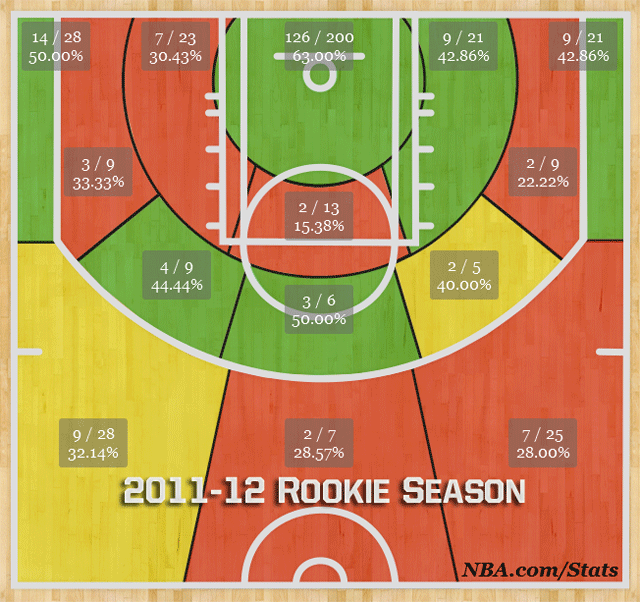
His improvement as a shooter comes both in the statistics and the eye test. In this winning 3-point shot against the Cavaliers last season, Kawhi showed off the improved shooting form by keeping the ball more in front of his head and less floating above it like a halo, and his body is much more balanced than the video you saw above.
He's not the only success story you'll ever see with going from being a non-shooter in college to a successful shooter in the NBA, and especially not when it comes to the Spurs' players, but the molding of his shot into someone they trust taking 3-point shots roughly three times per game is evident.
Finding ways to make teammates better
In college, Leonard was a playmaker in his second season because it's what the Aztecs needed him to be. They weren't a big program at all and didn't have a ton of talent in terms of guys who could consistently create good shots for themselves. They'd ask Leonard to overpower defenders, create an advantage for his team, and then move the ball if his own scoring opportunity wasn't created.
The Spurs have brought him along slowly in this department, mostly because they don't need him to be that guy. He's a cog in the system, looking to take the shot if a better shot can't be created through passing or a drive-and-kick. He's one of the better scorers in the pick-and-roll and he can post up, giving him a couple of good situations in which he's making a good initial pass that may nod lead to a direct assist, but can keep the Spurs' offensive engine running.
His passing numbers won't blow you away. He's not challenging LeBron James or Kevin Durant as elite playmakers at the forward position. However, combined with his other skills, what he does on the court is fairly rare. In the three years Leonard has been in the NBA, there are only eight players who have played significant minutes that have a rebounding rate, assist rate, and 3-point percentage similar to Leonard. And other than LeBron, only Leonard can be classified as a good or great wing defender on that list.
Drawing the toughest assignments without flinching
His defense is where he makes his biggest impact for the Spurs and is also where they ask him to do the most for them. Who is the best perimeter scorer on the opposing team tonight? That will be the guy Leonard is asked to stop. He may even be asked to mix in some defense on certain power forwards in order to keep them honest with how they attack his team's resistance.
As a rookie, they assigned him to stop Durant in the playoffs and Leonard got torched. It was a great lesson for Leonard and was a sign of showing his resilience in the face of failure. He came back in his second season a better defender, understanding angles and spacing much better than before and using them to his advantage. He'll crowd isolation scorers on their jump shot attempts about as well as anybody you'll see. Whether he's facing James, Durant, Paul George, or whomever, he's always working to stay uncomfortably close to his assignment and eliminate space.
As you can see in the video, he's constantly battling with his opponent, being physical, and pestering whatever shot he can. He can't really block Durant's shot but he can crowd it. He moves his feet beautifully to stay with George on every dribble, forcing him to hit tough shots just to taste success. And he can handle the perfect companionship of LeBron's brute strength and fast twitch muscles.
There aren't very many situations in which he doesn't come through defensively. He's one of the best players in the NBA, especially on the wing, at defending the pick-and-roll. He understands where his help is coming from and how to funnel players into that help. He uses his freaking 7'3" wingspan to make up for a 6'7" height that isn't ideal for defending some of these taller scorers. He closes out on shots and cuts off angles, all due to putting in the work on the practice court and having it translate to working even harder in the games themselves.
"He’s really good," Timberwolves coach Rick Adelman said. "He’s gotten better every year. He’s gone against all the people in the playoffs, I think that really helps him, like [LeBron] James last year and then all their match-ups. He’s just gotten better every year and he gives them that guy that he doesn’t demand a lot but he’s a key to what they do.”
Where does Leonard eventually peak as a player? None of us have the answer to that. We just know that he keeps wearing out everybody around him, whether it's the developmental staff of the Spurs or the opponents he's facing every night. Not everybody improves but Kawhi Leonard is improving at a fantastic rate.













